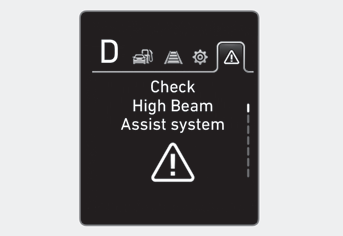Hyundai Venue: While Driving / Cruise Control
Cruise Control Operation

1. Cruise indicator
2. SET indicator
The Cruise Control system allows you to drive at speeds above 20 MPH (30 km/h) without depressing the accelerator pedal.
WARNING
Take the following precautions:
- Always set the vehicle speed under the speed limit.
- If the Cruise Control is left on, (cruise indicator light in the instrument cluster is illuminated) the Cruise Control can be activated unintentionally. Keep the Cruise Control system off (cruise indicator light OFF) when the Cruise Control is not in use, to avoid inadvertently setting a speed.
- Use the Cruise Control system only when traveling on open highways in good weather.
- Do not use the Cruise Control when it may be unsafe to keep the vehicle at a constant speed.
• Do not use when:
-- Driving in heavy traffic or when traffic conditions make it difficult to drive
at a constant speed
-- Driving on rainy, icy, or snowcovered roads
-- Driving on hilly or windy roads
-- Driving in windy areas
-- Driving with limited view (possibly due to bad weather such as fog, snow, rain
and sandstorm)
Information
- During normal cruise control operation, when the SET switch is activated or reactivated after applying the brakes, the cruise control will energize after approximately 3 seconds. This delay is normal.
- Before activating the cruise control function, the system will check to verify that the brake switch is operating normally. Depress the brake pedal at least once after turning ON the ignition or starting the engine.
- To set Cruise Control speed
- To increase/decrease Cruise Control speed
- To temporarily accelerate with the Cruise Control ON, Cruise Control will be canceled when
- To resume preset Cruising speed, To turn Cruise Control off
 Leading vehicle departure alert
Leading vehicle departure alert
Leading Vehicle Departure Alert function provides the alert whether the leading
vehicle drives away or not, while a stop.
System setting and operating Conditions
• Selecting Driver Attention Warning Leading Vehicle Departure Alert can be activated
from Users mode in the cluster LCD display by following the procedure below...
 To set Cruise Control speed
To set Cruise Control speed
1. Press the CRUISE button on the steering wheel to turn the system on. The cruise
indicator will illuminate.
2. Accelerate to the desired speed, which must be more than 20 MPH (30 km/h)...
Other information:
Hyundai Venue (QX) (2020-2025) Service Manual: Components and components location
..
Hyundai Venue (QX) (2020-2025) Service Manual: USB jack. Repair procedures
Removal 1. Disconnect the negative (-) battery terminal. 2. Remove the console upper cover. (Refer to Body - "Floor Console Assembly") 3. Remove the USB (A) after disengaging the hooks...
Categories
- Manuals Home
- 1st Generation Venue Owners Manual
- 1st Generation Venue Service Manual
- Rear Combination Light Bulb Replacement
- Trip Computer
- Electronic Stability Control (ESC)
- New on site
- Most important about car
Master warning mode

This warning light informs the driver the following situations.
-- Forward Collision-Avoidance Assist system malfunction (if equipped)
-- Forward Collision-Avoidance Assist radar blocked (if equipped)
-- Blind-Spot Collision Warning system malfunction (if equipped)
-- Blind-Spot Collision Warning radar blocked (if equipped)
-- Lamp malfunction (if equipped)
-- High Beam Assist malfunction (if equipped)
-- Tire Pressure Monitoring System (TPMS) malfunction (if equipped)
